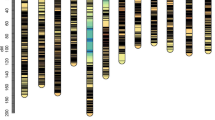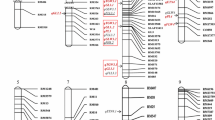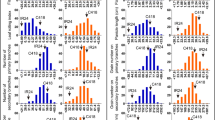Abstract
A permanent mapping population of rice consisting of 65 non-idealized chromosome segment substitution lines (denoted as CSSL1 to CSSL65) and 82 donor parent chromosome segments (denoted as M1 to M82) was used to identify QTL with additive effects for two rice quality traits, area of chalky endosperm (ACE) and amylose content (AC), by a likelihood ratio test based on stepwise regression. Subsequently, the genetics and breeding simulation tool QuLine was employed to demonstrate the application of the identified QTL in rice quality improvement. When a LOD threshold of 2.0 was used, a total of 16 chromosome segments were associated with QTL for ACE, and a total of 15 segments with QTL for AC in at least one environment. Four target genotypes denoted as DG1 to DG4 were designed based on the identified QTL, and according to low ACE and high AC breeding objectives. Target genotypes DG1 and DG2 can be achieved via a topcross (TC) among the three lines CSSL4, CSSL28, and CSSL49. Results revealed that TC2: (CSSL4 × CSSL49) × CSSL28 and TC3: (CSSL28 × CSSL49) × CSSL4 resulted in higher DG1 frequency in their doubled haploid populations, whereas TC1: (CSSL4 × CSSL28) × CSSL49 resulted in the highest DG2 frequency. Target genotypes DG3 and DG4 can be developed by a double cross among the four lines CSSL4, CSSL28, CSSL49, and CSSL52. In a double cross, the order of parents affects the frequency of target genotype to be selected. Results suggested that the double cross between the two single crosses (CSSL4 × CSSL28) and (CSSL49 × CSSL52) resulted in the highest frequency for DG3 and DG4 genotypes in its derived doubled haploid derivatives. Using an enhancement selection methodology, alternative ways were investigated to increase the target genotype frequency without significantly increasing the total cost of breeding operations.





Similar content being viewed by others
References
Belknap JK (2003) Chromosome substitution strains: some quantitative considerations for genome scans and fine mapping. Mamm Genome 14:723–732
Bernardo R, Charcosset A (2006) Usefulness of gene information in marker-assisted recurrent selection: a simulation appraisal. Crop Sci 46:614–621
Churchill GA, Doerge RW (1994) Empirical threshold values for quantitative trait mapping. Genetics 138:963–971
Cooper M, Podlich DW, Smith OS (2005) Gene-to-phenotype and complex trait genetics. Aust J Agric Sci 56:895–918
Cowley AW Jr, Roman RJ, Jacob HJ (2003) Application of chromosome substitution techniques in gene-function discovery. J Physiol 554:46–55
Dekkers JCM, Hospital F (2002) The use of molecular genetics in the improvement of agricultural populations. Nat Rev Genet 3:22–32
van Eeuwijk FA, Crossa J, Vargas M, Ribaut JM (2002) Analysing QTL-environment interaction by factorial regression, with an application to the CIMMYT drought and low-nitrogen stress programme in maize. In: Kang MS (ed) Quantitative genetics, genomics and plant breeding. CABI Publishing, Wallingford
Eshed Y, Zamir D (1995) An introgression line population of Lycopersicon pennellii in the cultivated tomato enables the identification and fine mapping of yield-associated QTL. Genetics 141:1147–1162
Harushima Y, Yano M, Shomura A, Sato M, Shimano T, Kuboki Y, Yamamoto T, Lin SY, Antonio BA, Parco A, Kajiya H, Huang N, Yamamoto K, Nagamura Y, Kurata N, Khush GS, Sasaki T (1998) A high-density rice genetic linkage map with 2275 markers using a single F2 Population. Genetics 148:479–494
He P, Li SG, Qian Q, Ma YQ, Li JZ, Wang WM, Chen Y, Zhu LH (1999) Genetic analysis of rice grain quality. Theor Appl Genet 98:502–508
Huang FS, Sun ZX, Hu PS, Tang SQ (1998) Present situations and prospects for the research on rice grain quality forming. Chin J Rice Sci 12(3):172–176
Kubo T, Aida Y, Nakamura K, Tsunematsu H, Doi K, Yoshimura A (2002) Reciprocal chromosome segment substitution series derived from Japonica and Indica cross of rice (Oryza sativa L.). Breed Sci 52:319–325
Lander ES, Botstein D (1989) Mapping Mendelian factors underlying quantitative traits using RFLP linkage maps. Genetics 121:185–199
Li H, Ye G, Wang J (2007) A modified algorithm for the improvement of composite interval mapping. Genetics 175:361–374
Mackill DJ, Ni JJ (2001) Molecular mapping and marker-assisted selection for major-gene traits in rice. In: Rice genetics, vol IV. Science Publishers, New Delhi, pp 137–151
McCouch SR, Teytelman L, Xu Y, Maghirang R, Li Z, Xing Y, Zhang Q, Kono I, Yano M, Fjellstrom R, DeClerck G, Schneider D, Cartinhour S, Ware D Stein L (2002) Development and mapping of 2240 new SSR markers for rice (Oryza sativa L.). DNA Res 9:199–207
Myers RH (1990) Classical and modern regression with applications, 2nd edn. Duxbury Thomson Learning, Pacific Grove
Nadeau JH, Singer JB, Martin A, Lander ES (2000) Analysis complex genetics traits with chromosome substitution strains. Nat Genet 24:221–225
Peleman JD, Voort JR (2003) Breeding by design. Trends Plant Sci 8:330–334
Piepho HP (2000) A mixed-model approach to mapping quantitative trait loci in barley on the basis of multiple environment data. Genetics 156:2043–2050
Podlich DW, Cooper M (1998) QU-GENE: a platform for quantitative analysis of genetic models. Bioinformatics 14:632–653
Tanksley SD, Nelson JC (1996) Advanced backcross QTL analysis: a method for the simultaneous discovery and transfer of valuable QTL from unadpated germplasm into elite breeding lines. Theor Appl Genet 92:191–203
Tsunematsu H, Yoshimura A, Harushima Y, Nagamura Y, Kurata N, Yano M, Sadaki T, Iwata N (1996) RFLP framework map using recombination inbred lines in rice. Breed Sci 46:279–284
Wan X-Y, Wan J-M, Su C-C, Wang C-M, Shen W-B, Li J-M, Wang H-L, Jiang L, Liu S-J, Chen L-M, Yasui H, Yoshimura A (2004) QTL detection for eating quality of cooked rice in a population of chromosome segment substitution lines. Theor Appl Genet 110:71–79
Wan X-Y, Wan J-M, Weng J-F, Jiang L, Bi J-C, Wang C-M, Zhai H-Q (2005) Stability of QTLs for rice grain dimension and endosperm chalkiness characteristics across eight environments. Theor Appl Genet 110:1334–1346
Wang J, van Ginkel M, Podlich D, Ye G, Trethowan R, Pfeiffer W, DeLacy IH, Cooper M, Rajaram S (2003) Comparison of two breeding strategies by computer simulation. Crop Sci 43:1764–1773
Wang J, van Ginkel M, Trethowan R, Ye G, DeLacy I, Podlich D, Cooper M (2004) Simulating the effects of dominance and epistasis on selection response in the CIMMYT Wheat Breeding Program using QuCim. Crop Sci 44:2006–2018
Wang J, Eagles HA, Trethowan R, van Ginkel M (2005) Using computer simulation of the selection process and known gene information to assist in parental selection in wheat quality breeding. Aust J Agric Sci 56:465–473
Wang J, Wan X, Crossa J, Crouch J, Weng J, Zhai H, Wan J (2006) QTL mapping of grain length in rice (Oryza sativa L.) using chromosome segment substitution lines. Genet Res 88:93–104
Wang J, Chapman SC, Bonnett DB, Rebetzke GJ, Crouch J (2007) Application of population genetic theory and simulation models to efficiently pyramid multiple genes via marker-assisted selection. Crop Sci 47:580–588
Young ND (1999) A cautiously optimistic vision for marker-assited selection. Mol Breed 5:505–510
Zeng Z-B (1994) Precision mapping of quantitative trait loci. Genetics 136:1457–1468
Acknowledgments
The authors wish to thank Professor A. Yoshimura, Kyushu University, Japan for providing the CSS lines. This work was supported by the National 973 and 863 Programs of China (No. 2006CB101700 and 2006AA10Z1B1), and the Generation and HarvestPlus Challenge Programs of the Consultative Group for International Agricultural Research.
Author information
Authors and Affiliations
Corresponding author
Additional information
Communicated by F. van Eeuwijk.
Rights and permissions
About this article
Cite this article
Wang, J., Wan, X., Li, H. et al. Application of identified QTL-marker associations in rice quality improvement through a design-breeding approach. Theor Appl Genet 115, 87–100 (2007). https://doi.org/10.1007/s00122-007-0545-x
Received:
Accepted:
Published:
Issue Date:
DOI: https://doi.org/10.1007/s00122-007-0545-x




